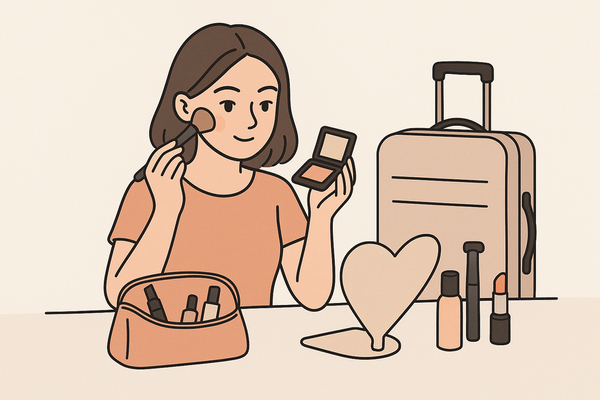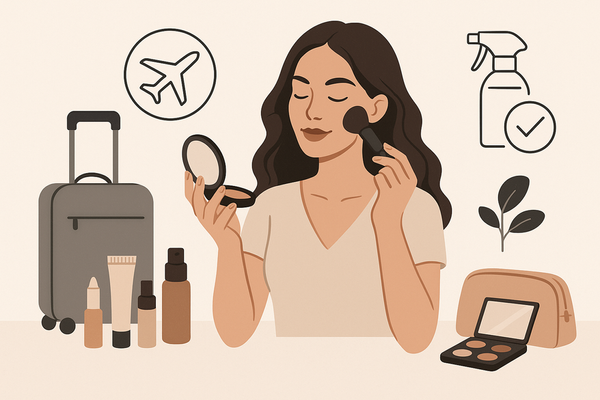How to Create a Sustainable Makeup Routine: A Step-by-Step Guide
Learn how to transition to a sustainable makeup routine with eco-friendly products and ethical practices. Protect the planet and enhance your beauty regimen.

Estimated reading time: 10 minutes
Key Takeaways
- Define a sustainable makeup routine and its three pillars: environmental responsibility, ethical sourcing, and cruelty-free testing.
- Understand core principles like renewable ingredients, fair-trade practices, and eco-friendly packaging.
- Learn a step-by-step transition: audit your kit, plan gradual swaps, and choose multitasking products.
- Discover essential product categories, eco-ingredients, and top sustainable brands.
- Maintain your routine with proper storage, recycling, and community engagement tips.
Table of Contents
- What Is a Sustainable Makeup Routine?
- Key Principles of a Sustainable Makeup Routine
- Traditional vs. Sustainable Makeup Routine Approaches
- Benefits of a Sustainable Makeup Routine
- Essential Components of a Sustainable Makeup Routine
- How to Build and Transition to a Sustainable Makeup Routine
- Spotlight on Eco-Friendly Makeup Brands
- Tips for Maintaining and Enhancing Your Sustainable Makeup Routine
- Conclusion
Starting with an eco-friendly approach to makeup transforms your beauty routine into a force for good. A sustainable makeup routine prioritizes environmental responsibility, ethical sourcing, and animal welfare, using green manufacturing processes and cruelty-free formulas.
Right now, sustainable makeup matters more than ever: demand for ethical beauty is soaring, with green beauty ranges growing over 20% in the last two years.
In this guide, you’ll explore:
- What a sustainable makeup routine means
- Key principles and benefits
- Core product categories and eco-ingredients
- Steps to transition your daily kit
- Top eco-friendly makeup brands
- Tips for upkeep and community building
For insights into clean beauty makeup trends, check out our blog. And for a data-driven approach, Makeup Check AI offers instant analysis of your products. Watch how it works below:
Section 1: What Is a Sustainable Makeup Routine?
A sustainable makeup routine is defined as beauty practices that prioritize environmental responsibility, ethical sourcing, and long-term health. It uses products and methods that minimize harm to people, animals, and the planet. This formal definition comes from leading eco-beauty experts.
Three pillars support a sustainable makeup routine:
- Environmental responsibility – choosing renewable-resource ingredients, green chemistry, and low-impact processes.
- Ethical ingredient sourcing – harvesting botanicals in ways that respect ecosystems and labor rights.
- Animal welfare/cruelty-free testing – avoiding any form of animal testing or by-product.
Example in practice: Swap a synthetic lipstick in plastic packaging for a plant-based, refillable bullet. You reduce single-use waste and embrace biodegradable formulas. This quick shift cuts packaging trash and lowers your carbon footprint.
Section 2: Key Principles of a Sustainable Makeup Routine
Environmental Impact
- Use ingredients from renewable resources like bamboo, coconut oil, and sugarcane-based ethanol.
- Favor green manufacturing: brands powered by solar, wind, or low-emission processes reduce pollution.
- Lower carbon footprint by sourcing locally or supporting companies with verified offset programs.
Ethical Sourcing
“Harvesting ingredients in ways that respect ecosystems and labor rights” means:
- Working with fair-trade cooperatives to ensure farmers earn living wages.
- Avoiding deforestation by choosing palm oil alternatives like jojoba or sunflower seed oil.
- Verifying supply chains through blockchain or third-party audits for transparency.
Cruelty-Free Testing
- Look for Leaping Bunny, PETA, or Cruelty Free International logos.
- Support brands that certify no animal tests on ingredients, formulations, or finished goods.
- Embrace in-vitro and computer modeling alternatives for safety assessments.
Sustainable Packaging
- Recyclable plastics (PCR) or aluminum over virgin plastic.
- Refillable compacts and travel-friendly solids minimize single-use trash.
- Biodegradable materials—paperboard, bioplastics, bamboo—break down in compost.
- Minimalist packaging reduces ink, coatings, and excess cartons. Learn proper disposal methods at eco-friendly makeup disposal guide.
Section 3: Traditional vs. Sustainable Makeup Routine Approaches
Traditional makeup routines often:
- Rely on petrochemicals, phthalates, parabens, and synthetic dyes
- Use single-use plastics and opaque supply chains
- Test on animals or source from unverified suppliers
Sustainable makeup approaches:
- Feature natural or organic ingredients (botanical extracts, mineral pigments)
- Offer transparent sourcing and eco-friendly certifications
- Employ cruelty-free testing standards and refillable packaging
Section 4: Benefits of a Sustainable Makeup Routine
Health Benefits
Fewer harsh chemicals reduce the risk of skin irritation, dryness, and contact dermatitis. Natural oils and plant extracts nourish the skin barrier with vitamins A, C, E, and essential fatty acids. Hypoallergenic mineral pigments (zinc oxide, titanium dioxide) offer safe sun protection without nanoparticles.
Environmental Benefits
Supporting biodiversity: sourcing wild-crafted herbs responsibly maintains habitats. Water conservation: low-water manufacturing and waterless formats (solid bars, powder products) save liters per use. Lower carbon footprint: local sourcing and refill stations cut shipping emissions.
Waste Reduction
Refillable palettes and bulk buys eliminate single-use plastic. Recyclable tubes and jars made with post-consumer resin (PCR) divert waste from landfills. Minimalist designs use less ink, fewer adhesives, and lightweight materials.
Ethical Impact
Fair-trade labor practices uplift farming communities and ensure safe working conditions. Cruelty-free policies reinforce animal welfare and support the global Leaping Bunny standard. Transparent reporting and third-party audits build consumer trust.
Section 5: Essential Components of a Sustainable Makeup Routine
Must-Have Product Categories
- Foundation/Concealer with mineral or organic bases: zinc oxide, mica, kaolin clay.
- Lipstick/Blush in plant-based formulas: jojoba oil, shea butter, beetroot pigment.
- Mascara using natural waxes (carnauba, candelilla) and castor oil in recycled tubes.
- Eyeshadows and highlighters made from mica mined under ethical standards.
- Multiuse products—tinted balms serve as lip, cheek, and eye tint to reduce total items.
Eco-Friendly Ingredients
Botanical extracts: chamomile, green tea, calendula soothe and protect. Essential oils: lavender, tea tree, rosehip for aroma and skin benefits. Natural pigments: iron oxides, ultramarines, carmine alternatives for bright color. Free from parabens, sulfates, synthetic fragrances, and nanoparticles.
Product-Selection Tips
Check for USDA Organic, COSMOS, or EcoCert certifications on labels. Prioritize refillable systems—compact shells, magnetic palettes, and dropper bottles. Choose solid bars or powders to skip water and reduce preservatives. Look for cruelty-free logos (Leaping Bunny, PETA) to confirm no animal testing. Scout bulk-buy options and zero-waste shops to minimize shipping and packaging.
Section 6: How to Build and Transition to a Sustainable Makeup Routine
Step 1: Audit Your Makeup Drawer
Gather all your products and note which lack eco-credentials. Toss expired items and set aside non-refillable plastics for recycling.
Step 2: Plan Gradual Swaps
Schedule one product swap per month to avoid budget shock. Replace staples first—foundation, lipstick—then tackle niche items like glitter gels.
Step 3: Swap Disposable Tools
Trade cotton pads, Q-tips, and single-use sponges for bamboo brushes and washable rounds. Invest in a quality brush set with natural bristles or recycled nylon.
Step 4: Choose Multitasking Products
A tinted balm can double as blush and lip color. A solid cream eyeshadow stick simplifies your kit and reduces boxes.
Step 5: Verify Brand Transparency
Read ingredient lists and look up sourcing statements on brand websites. Seek out annual sustainability reports or impact pages. Use apps like Think Dirty or EWG’s Skin Deep to check product ratings.
Section 7: Spotlight on Eco-Friendly Makeup Brands
RMS Beauty
Organic, high-performance formulas free of synthetic fillers and fragrances. Uses unrefined, cold-pressed oils for skin nourishment.
Ilia Beauty
Refillable face palettes and tubes with reef-safe UV filters. Transparent sourcing and carbon-neutral shipping initiatives.
Kjaer Weis
Luxury metal compacts designed for lifetime refills. COSMOS-certified organic ingredients and fair-trade supply chains.
Axiology
Vegan lipsticks in compostable paper tubes. Certified cruelty-free and cruelty-free palm oil alternative.
So Eco
Award-winning zero-waste designs and recycled packaging. Solid sticks and bars to reduce water and plastic use.
Section 8: Tips for Maintaining and Enhancing Your Sustainable Makeup Routine
Proper Storage
Keep products in cool, dry places away from direct sunlight to extend shelf life. Use acrylic or bamboo organizers instead of plastic bins.
Recycling and Reusing Empties
Rinse jars and tubes before placing them in curbside recycling. Join brand take-back programs like MAC’s Back to MAC or Kiehl’s recycling scheme. Repurpose empty containers as travel pots or seedling planters.
Ongoing Education
Follow eco-beauty blogs and Instagram accounts for new product drops and research. Attend virtual green beauty summits and webinars to learn best practices. Subscribe to brand newsletters for updates on refill launches and sustainability reports.
Community Engagement
Share your sustainable makeup finds using hashtags like #ZeroWasteBeauty or #EcoGlow. Swap tips, empty-product reviews, and DIY recipes in online groups to build accountability. Engage with local green initiatives, workshops, or meet-ups to stay motivated.
Conclusion
A sustainable makeup routine combines environmental responsibility, ethical sourcing, and cruelty-free testing into every product and practice. By understanding core principles, swapping to eco-friendly products, and supporting transparent brands, you protect your skin and the planet. Start your journey by replacing one product today. Share your first swap on social media and tag a friend to join the movement. Every small change adds up to a big impact—for better skin, cleaner ecosystems, and a more ethical beauty industry.
FAQ
What makes a makeup routine truly sustainable?
A sustainable makeup routine uses ingredients from renewable sources, upholds ethical labor practices, avoids animal testing, and minimizes packaging waste.
How can I identify eco-friendly beauty brands?
Look for certifications like USDA Organic, COSMOS, EcoCert, Leaping Bunny, PETA, and transparent sustainability reports or third-party audits.
Are sustainable products more expensive?
While some eco-friendly products carry a premium due to ethical sourcing and small-batch production, multitasking items and refillable systems can save money long term.
How do I dispose of non-recyclable packaging?
Check brand take-back programs or zero-waste stores that accept hard-to-recycle materials. Some items can be repurposed for storage or crafts.
Can I transition gradually without overhauling my entire kit?
Absolutely. Audit your collection, plan one swap per month, and invest in multitaskers to streamline the shift without breaking the bank.




